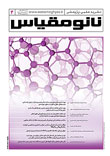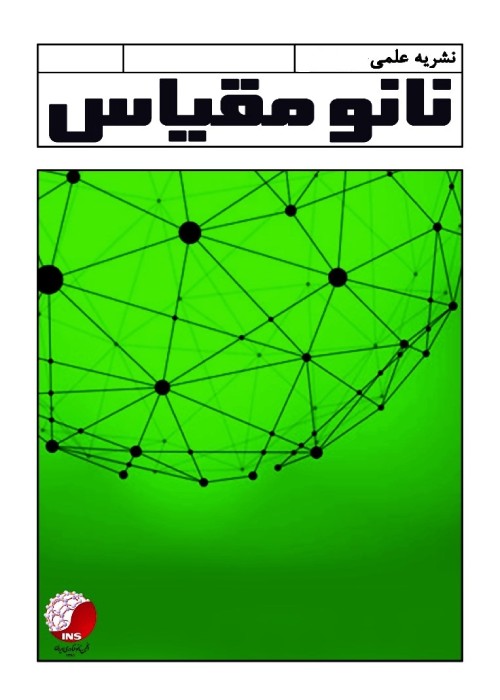فهرست مطالب

فصلنامه نانو مقیاس
سال سوم شماره 3 (پیاپی 11، پاییز 1395)
- تاریخ انتشار: 1395/10/10
- تعداد عناوین: 8
-
-
صفحه 129تبدیل نور به انرژی با استفاده از سلولهای خورشیدی به صورت گسترده طی 50 سال گذشته با استفاده از ترکیبهای مختلفی از نیمرساناها مورد مطالعه قرار گرفته است. پروسکایتهای آلی-معدنی دسته جدیدی از جاذبهای نور هستند که اخیرا مورد توجه قرار گرفتهاند. گاف انرژی مستقیم، ضریب جذب و تحرکپذیری بالا، این مواد را به جاذبهای مناسبی در سلولهای خورشیدی تبدیل کرده است.مورفولوژی،استوکیومتری و کریستالینیتی این مواد روی عملکرد سلول موثر بوده، به همین دلیل روش لایه نشانی این مواد اهمیت زیادی دارد. بازده سلولهای پروسکایت، تنها با تغییر و بهبود روش لایهنشانی، طی دو سال از 9 تا 15 افزایش یافته است.در این پژوهش، از روش دو مرحلهای برای لایهنشانی پروسکایت استفاده شده است.به منظور بهبود عملکرد سلول، پارامترهای مختلفی از جمله ضخامت فیلم TiO2، غلظت محلول CH3NH3I و یا زمان غوطهوری بهینهسازی شده است. در نهایت در شرایط بهینه، بیشینه بازدهی 9/11 از این سلول ها حاصل شد.کلیدواژگان: پروسکایت های آلی معدنی، روش دومرحله ای، سلول خورشیدی
-
صفحه 135در این کار، به بهینه سازی عملکرد حسگر زیستی مبتنی بر بلورهای فوتونی یک بعدی پرداخته شده است. بلور فوتونی مورد استفاده متشکل از لایه های A، B وF است که به ترتیب ZnSe، SiO2 وکانالی است که امکان جاری شدن سیال حاوی ماده ی زیستی را فراهم می نماید. همچنین، در مرکز بلور فوتونی لایه ی نقص D با تابع توزیع ضریب شکست شعاعی قرار می گیرد. با تابش نور تخت به ساختار بلور فوتونی معرفی شده، شدت نور خروجی توزیع فضایی پیدا کرده و این امر منجر به تولید حلقه های روشن نور در صفحه ی خروجی می شود. تغییرات ایجاد شده درضریب شکست موثر سیال جاری در کانال ها منجر به تغییر شعاع این حلقه ها می گردد. پارامترهای متعددی از جمله تعداد، ضخامت لایه ها و شیب تغییرات ضریب شکست در لایه ی D در میزان این حساسیت تاثیر دارند. با بهینه کردن این پارمترها، تغییرات ضریب شکست-5^ 10 در سیال به اندازه ی قابل تشخیص است.کلیدواژگان: بلورهای فوتونی یک بعدی، حسگرهای زیستی، مواد با ضریب شکست متغیر
-
صفحه 143در این مقاله یک سیستم مزوسکوپیکی مبتنی بر لایه های گرافنی معلق در یک دی الکتریک برای بهبود نمایش دوپایداری نوری در محدوده تراهرتز پیشنهاد شده است. ابتدا نشان داده شده است که در سیستم مزبور، غیرخطیت نوری در محدوده تراهرتز نسبت به محدوده مرئی افزایش چشمگیری می یابد. همینطور نشان داده شده است که رفتار غیرخطی سیستم با افزایش تعداد لایه های معلق نیز افزایش می یابد. برای تحلیل این مسائل، ابتدا از نتایج معادله بولتزمان برای تشریح هدایت اپتیکی استفاده شده و سپس با ردگیری موج اپتیکی تراهرتز در عبور از لایه های گرافنی معلق با استفاده از معادلات ماکسول، نمودار هیسترسیز دوپایداری اپتیکی بدست آمده است. نتایج حاکی از تقویت دوپایداری بازای افزایش لایه هاست. بنابراین می توان با تغییر تعداد لایه ها، غیر خطیت سیستم را تنظیم نمود. همینطور می توان با اعمال ولتاژ بایاس بر سیستم بهینه شده، غیرخطیت را بروش الکتریکی تنطیم نمود.کلیدواژگان: آشوب، دوپایداری، گرافن، تراهرتز
-
صفحه 151دیودهای نورتاب آلی OLEDs نوع جدیدی از تکنولوژی نوری هستند که در دو دهه اخیر گوی سبقت در حوزه تحقیقات ادوات نوری، نسبت به دیگر رقبا را ربوده اند. ساختار اصلی OLED ها شامل یک لایه آلی از مواد نورتاب بعلاوه چندین لایه آلی یا معدنی است که نقش آنها تزریق یا انتقال بار است. شفافیت لایه ها باعث خروج نور تولیدی از آنها می شود. در این پروژه، استفاده از ضخامت های پایین نقره منجر به ساخت OLED هیبریدی نیمه شفاف با ساختار معکوس شد. با تغییر ضخامت نقره که توسط سیستم تبخیری لایه نشانی شد، کمینه ضخامت لازم برای ساخت LED با ساختار «ITO/ZnO/Cs2Co3/PDY/MoO3/Ag» حدود nm 30 بدست آمد. آنالیز نوری عبوری نشان از تشکیل جزیره ای لایه ی نقره در ضخامت های کم داشت. تصاویر میکروسکوپ اتمی AFM نشان داد که در ضخامت های ببیشتر از nm 10، با افزایش ضخامت، زبری سطحی نیز افزایش می یابد. ماکزیمم شدت نورتابی بدست آمده برای دیود نیمه شفاف cd/m2 2290 و بازده جریان آن حدود cd/A 1 بود.کلیدواژگان: OLED، نیمه شفاف، هیبریدی، نقره، ساختار معکوس
-
صفحه 159در این پژوهش، نانوذرات MnxFe0.7-xZn0.3Fe2O4، با استفاده از روش همرسوبی تهیه شدند. در این ترکیب مقدار x از 0 تا 7/0 می باشد. ویژگی های ساختاری و مغناطیسی پودرهای سنتز شده، به وسیله پراش سنج پرتو ایکس XRD، طیف سنج فروسرخ دور Far-FTIR، میکروسکوپ الکترونی عبوری TEM و مغناطیس سنج نمونه ارتعاشی VSM مورد بررسی قرار گرفتند. نتایج پراش پرتو ایکس نشان می دهد که تمام نمونه های تهیه شده دارای ساختار اسپینلی تک فاز هستند. میانگین اندازه بلورک ها با استفاده از رابطه شرر در محدوده ی12 تا 7 نانومتر تخمین زده شدند. در نتایج طیف سنجی فرو سرخ دور، دو باند فرکانسی 1v و 2v در محدوده ی cm-1300 تا cm-1600 وجود دارد که حضور برهمکنش کاتیون- آنیون را در جایگاه های هشت وجهی و چهار وجهی نشان می دهند. تصاویر میکروسکوپ الکترونی عبوری توزیع یکنواخت اندازه ذرات را نشان می دهند. همچنین نتایج مغناطیس سنج نمونه ارتعاشی نشان می دهد که با افزایش ناخالصی منگنز، مغناطش اشباع برای تمام نمونه ها کاهش می یابد.کلیدواژگان: فریت آهن، روی، نانوذرات مغناطیسی، پراش پرتو ایکس، همرسوبی، مغناطیس سنج نمونه ارتعاشی
-
Page 129Light-energy conversion by photoelectrochemical cells has been extensively studied in the past 50 years using various combinations of semiconductors. Organicinorganic perovskites have recently attracted increasing attention as light absorber. A direct band gap, strong light absorption, and high carrier mobility make them excellent absorber in solar cells. The morphology, stoichiometry and crystallinity of perovskites have significant effect on the device performance significantly, then deposition techniques are critical to achieve high efficiency solar cells. Efficiency of perovskite solar cells improve from 9 to 15 in two years due to change of deposition method. In this research, the two step technique was employed for the deposition of perovskite films. Different parameters of this method such as TiO2 thickness, concentration of the CH3NH3I solution and dipping time in the CH3NH3I solution were optimized. Finally, in optimized condition, we obtained a power conversion efficiency of 11.9.Keywords: Organic–inorganic perovskite, Two, Step technique, Solar cell
-
Page 135In this work, we have optimized the performance of the 1D photonic crystal based biosensor. The photonic crystal contains the layers A, B and F which are ZnSe, SiO2 and a microfluidic channel, respectively. Also, there is a radial gradient refractive index defect layer in the center of the structure. By irradiating a plane beam to the proposed structure, a ring-shaped intensity profile is achieved on the output plane of the structure. Any changed in the effective refractive index of the fluid inside of microfluidic channels can cause a change in the radius of the intensity ring. There are different parameters such as number and thickness of the layers and the rate of the refractive index variation in the D layer that can effect the sensitivity. Optimizing these parameters, it is possible to sense the refractive index changes of 10^-5 .Keywords: 1D Photonic Crystal Nanostructures, Biosensors, Gradient Refractive Index Materials
-
Page 143In this paper, a mesoscopic-scaled system is proposed based on the embedded graphene layers inside a dielectric medium in order to improve the presentation of optical bistability in THz range. It is firstly shown that the nonlinearity is considerably enhanced in comparison to the visible range. It is also shown that the nonlinear behavior can be increased by increasing the number of graphene layers. For the purpose of analyzing these issues, we use Boltzmann equation to describe the optical conductivity. Then, THz light wave is traced through the embedded graphene layers via Maxwell equations. This yields the optical bistability hysteresis. The results show that the optical bistability is enhanced with increasing the number of graphene layers. The important issue in THz range is the tunability of nonlinearity with an external bias voltage.Keywords: Optical Bistability, Chaos, Graphene, Terahertz
-
Page 151In recent two decades, a large share of lighting research has been assigned to investigation on organic light emitting diodes OLEDs. The basic structure of OLEDs consist of an organic emissive layer and another layers as injection or transporting layers which can be organic or inoarganic. In this report, with varying of silver thickness which acts as anode layer we could fabricated a semi-transparent hybrid LED. The minimum thickness which OLED with structure of ITO/ZnO/Cs2Co3/PDY/MoO3/Ag emits light both side was about 30 nm. The optical transmittance analysis showed Ag layers with thickness lower than 20 nm has been grown in island mode. In thick Ag layers, atomic force microscopy demonstrated that roughness is increased as Ag thickness is increased. The maximum brightness for semi-transparent hybrid LED was about 2290 cd/m2 with current efficiency of about 1 cd/A.Keywords: OLED, semi, transparent, hybrid, silver, inverted structure
-
Page 159In this researcher, the MnxFe0.7-xZn0.3Fe2O4 ferrite nanoparticles prepared by co-precipitation method. In these compositions the value of x varies from 0 to 0.7. Structural and magnetic properties of synthesized powder were characterized by X-ray diffraction XRD, Far-Infrared spectroscopy Far-FTIR, Transmission Electron Microscopy TEM and vibration sample magnetometer VSM. The XRD results show that all of the samples have single phase spinel structure. The average crystallite size estimated of about 12 to 7 nm, using Scherrer´s formula. The Far-FTIR measurements show, two frequency bonds within the rang 300 to 600 cm-1 indicate the presence of cation-anion interactions in the octahedral and tetrahedral sites, respectively.Also Transmission Electron Microscope images show particles size uniform distribution. The VSM results show that the saturation magnetization for all the samples decrease by increasing the manganese content.Keywords: Fe, Zn ferrite, Magnetic nanoparticles, Co, precipitation, X-ray diffraction, Vibration sample magnetometer


